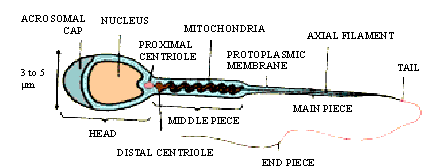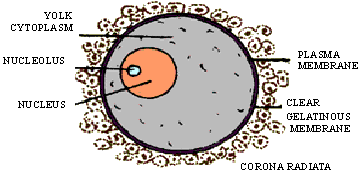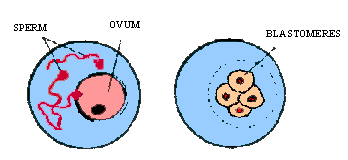|
PinkMonkey Online Study Guide-Biology
24.3 Embryonic Development

Click here for enlargement
Figure 24. 8 Structure of a spermatozoan
(I) Structure of spermatozoa (Figure 24.8). Typically,
each sperm consists of an anterior head, an intermediate
middle piece, and a posterior tail. The head contains
a nucleus with haploid chromosomes, and the acrosome which
effects penetration of the sperm into the egg. The middle piece
has proximal and distal centrioles, the axial filament
and numerous mitochondria which provide energy for locomotion
of the sperm. The tail is long and consists of the main piece and
end piece, with central axial filament, fibrils, and partly covered
by protoplasmic membrane. The human sperm is about 0.05 mm in length
, and a single ejaculation (about 4 ml) contains some 300 million
cells. To fertilize the egg, more than 60 to 80 million sperm cells
are required per ejaculation. Such high sperm count is necessary
to induce pregnancy.
-
Structure of ovum. When the Graafian follicle
is ripe (10-20 mm in diameter), it projects from the ovarian surface,
finally bursts and releases the mature ovum (ovulation) into the funnel
of the oviduct. The mature ovum (Figure 24.9) is roughly spherical,about
100 to 200 microns in diameter. The mature ovum has a nucleus (eccentric
in position) and nucleolus, commonly called the germinal vesicle
and germinal spot, respectively. The protoplasm of the ovum,
called ooplasm (yolk or vitellus) provides nutrition during
early embryonic development. The cell membrane of the ovum is called
vitelline membrane or oolemma. Since it appears as a
colorless zone, it is also called the zona pellucida. The space
between the vitellus or ooplasm and the vitelline membrane is called
perivitelline space. (Polor bodies are lodged in this space.)
When the mature ovum is discharged,some of the follicle cells are
still attracted radially around the ovum, called corona radiata.
The ovum is propelled down the oviduct to the uterus by ciliated cells;
this transfer takes several hours.

Figure 24. 9 A mature ovum
During copulation, the spermatozoa are deposited in
the vagina, which may result in pregnancy. Pregnancy entails
a sequence of many events, including fertilization, cleavage, implantation,
embryonic growth (up to the end of 2nd month), and fetal growth (2nd
month to the birth of the fetus) that ends with the birth of the baby.
Fertilization (Fig. 24.10)

(A) Fertilization (B) Cleavage
[next page]
|
Table of Contents
24.0 Introduction
24.1 Human reproduction
24.2 Female reproductive cycle
24.3 Embryonic Development
Chapter 25
|